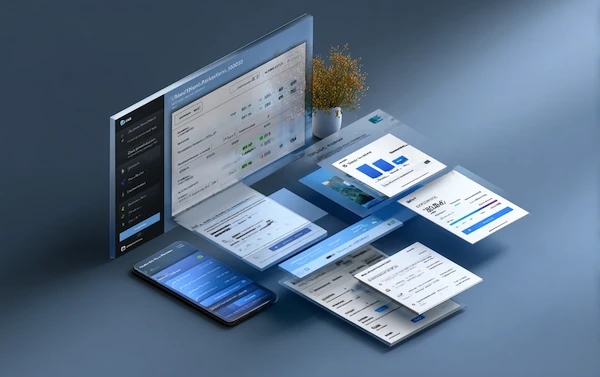What is Data Reconciliation? Best Practices, Tools, and Importance

When you have access to seemingly infinite data, it only makes sense to put it to good use for business insights and decision making capabilities. To do so properly, data reconciliation must take place. But, how can you manage all the data in so little time?
We’re going to share some data reconciliation best practices and take a look at the best reconciliation software to streamline the heavy lifting.
Coming Up
Why is Data Reconciliation Important?
Data Reconciliation Challenges and How to Overcome Them
What Terminology is Linked with Data Reconciliation?
What are the Types of Data Reconciliation Methods?
What are Best Practices of Using Data Reconciliation?
What are the Best Data Reconciliation Tools?
What is Data Reconciliation?
Data reconciliation is the systematic process of validating data accuracy during migration and integration phases. When transferring data between systems, this crucial verification step ensures that target data matches source data perfectly. Using sophisticated mathematical models, data reconciliation tools compare datasets to identify and resolve discrepancies before the information is used for business intelligence.
For example, a retail company might use data reconciliation techniques to verify that sales data from their point-of-sale systems matches their inventory management system. This type of data reconciliation example shows how businesses can maintain data integrity across multiple platforms.
Why is Data Reconciliation Important?
When making decisions within an organization, you want to remove the guesswork as much as possible. Naturally, the go-to place for verification before moving forward relies on the data - numbers and figures don’t lie! That is, if they are correct in the first place.
Data reconciliation serves as checks and balances so that you can trust your data with high confidence and remove the risk of errors. Achieving accurate and consistent data through data reconciliation is crucial, especially when dealing with multiple data sources that can lead to discrepancies.
Data can be used to implement new marketing campaigns (based on customer buying preferences), product development (based on product/market fit), and forecasting next steps (based on historical and past events).
These are just a few reasons how data can impact a business’ overall functions and operations. Thus, it is of key importance to have the right data in hand. Improved data accuracy enhances decision-making, boosts trust in reporting and analysis, prevents errors, and ensures compliance with regulatory requirements.
While the influx of data is hardly a challenge, data management and storage has increasingly caused hardship for businesses seeking to modernize their systems.
As a result, finance automation solutions have emerged to quell the burden. A tool like Solvexia connects your data systems across the board, centralizes your data, and performs data reconciliation automatically to make sure that your data is always up-to-date, clean, and ready to apply for insights to derive value.
Data Reconciliation Challenges and How to Overcome Them
Organizations frequently encounter several key challenges when implementing data reconciliation processes. Understanding these challenges and having strategies to address them is crucial for successful data management.
1. Siloed Systems and Data Sources
Challenge: Many organizations operate with multiple systems that don’t naturally communicate with each other, creating data silos that complicate reconciliation efforts.
Solution:
- Implement integration platforms that connect different systems
- Use data reconciliation tools with built-in connectors
- Adopt standardized data formats across systems
2. Manual Processing Bottlenecks
Challenge: Traditional manual reconciliation processes are time-consuming, error-prone, and can't scale with growing data volumes.
Solution:
- Leverage automation tools for routine reconciliation tasks
- Use no-code platforms that empower business users
- Implement automated exception handling
3. Complex Data Transformations
Challenge: Data from different sources often comes in varying formats and structures, making comparisons difficult.
Solution:
- Use modern data reconciliation tools with built-in transformation capabilities
- Implement standardized data mapping processes
- Utilize no-code transformation tools for business users
4. Real-time Reconciliation Needs
Challenge: Modern businesses need near real-time data validation, which is impossible with manual processes.
Solution:
- Deploy automated reconciliation systems with real-time capabilities
- Set up automated alerts for discrepancies
- Use streaming data processing for continuous reconciliation
5. Compliance and Audit Requirements
Challenge: Meeting regulatory requirements while maintaining efficient reconciliation processes can be complex.
Solution:
- Implement automated audit trail generation
- Use tools with built-in compliance reporting
- Maintain detailed documentation of reconciliation rules
Effective data governance is crucial in establishing a framework that includes policies and guidelines for data reconciliation, ensuring accuracy and integrity in data management.
By addressing these challenges with modern data reconciliation tools and automation solutions, organizations can significantly improve their data quality and operational efficiency.
What Terminology is Linked with Data Reconciliation?
Whether you choose to perform data reconciliation manually or with the help of automation software, there are some useful terms to know, including:
- Discrepancy - The difference between two data sets that should be investigated and explained
- Benchmark accepted value - This is a known accepted value that’s utilized to compare two data sets.
- Observability - This kind of analysis provides information about what variables can be determined within a dataset, given a set of constraints and measurements.
What are the Types of Data Reconciliation Methods?
There are a few different data reconciliation techniques that can be deployed to fulfill the data reconciliation process. These include:
1. Master Data Reconciliation
Master data reconciliation involves cross-checking the master data between its source and target. Since master data is unlikely to change rapidly, there’s no aggregation needed.
Some examples of master data reconciliation involve checking: total number of rows, total number of items, number of active users, total customer in source and target, etc.
2. Transactional Data Reconciliation
The foundation of business intelligence reports is built upon transactional data reconciliation. This is the process of comparing transactional records.
For example, transactional data reconciliation may compare the sum of the total income calculated from a source and a target, or it could look at the sum of the entire item sold in both the source and target (quantity).
3. Automated Data Reconciliation
Automating the data reconciliation process saves time and prevents errors from occurring. With automated data reconciliation, the system performs the record matching and alerts the team of any discrepancies that need review.
With automated data reconciliation, your business gains increased visibility and stakeholders have unparalleled internal control such as audit trails (with version history).
Best Practices for Data Reconciliation
To ensure successful data reconciliation implementation and maintenance, follow these comprehensive best practices:
1. Establish Data Quality Standards
- Define acceptable tolerance levels for different types of data
- Create clear data validation rules and criteria
- Document expected formats and standards for all data sources
- Set up data quality scorecards for regular monitoring
2. Implement Strong Controls
- Establish segregation of duties for data validation and approval
- Create detailed audit trails for all reconciliation activities
- Set up multi-level review processes for critical data sets
- Define clear escalation paths for discrepancies
3. Automate Strategically
- Start with high-volume, routine reconciliations
- Build automated validation rules based on historical patterns
- Configure real-time alerts for significant variances
- Implement automated documentation of reconciliation results
4. Address Discrepancies Promptly
- Establish SLAs for investigating and resolving differences
- Create a standardized process for documenting resolution steps
- Maintain a knowledge base of common issues and solutions
- Regular review of unresolved items to prevent backlog
5. Maintain Data Hygiene
- Regular cleansing of master data
- Periodic review and updates of matching rules
- Scheduled maintenance of reference data
- Routine cleanup of historical reconciliation records
6. Monitor and Improve
- Track reconciliation completion rates and timing
- Measure error rates and resolution times
- Analyze patterns in discrepancies to prevent future issues
- Regular review and updates of reconciliation rules
7. Focus on Training and Documentation
- Develop comprehensive procedure manuals
- Provide regular training for team members
- Document system configurations and changes
- Maintain updated user guides for reconciliation tools
What are the Best Data Reconciliation Tools?
When you’re ready to implement a data reconciliation tool to help improve your business’ insights and confidence in its data, consider using a reconciliation tool like Solvexia.
Solvexia is a finance automation software that enables data processing, secure database storage, no-code automation, reporting, and audit trails.
Solvexia is designed to help teams with an array of complex business processes and finance functions, such as: reconciliation, reporting, expense management, rebate management, and the like.
With Solvexia, you can manipulate files automatically into any format. The system will connect with your existing technologies, including legacy systems and centralize your data. As such, your team will be able to reduce errors by 90% and run processes 100x faster.
This way, you have an overview of how your business is performing, along with its financial data, in real-time and with utmost accuracy.
The ability to centralize and utilize your data for insights provides you with a competitive edge and optimizes your decision-making abilities. It also helps to better service customers and add more value, making it possible to work smarter and enable maximum controls over processes.
Solvexia comes with a library of supported data connectors (or you can create your own) to unify all your data. With automated data transformation and drag-and-drop features, anyone can simply use the system, without the need for dedicated IT teams or coding.
The out-of-the-box solutions allow you to aggregate, filter, sort, map, and reconcile data immediately.
Final Thoughts
Having data available in your business is just the beginning of being able to derive value from the figures. In order to transform the data into insights, data reconciliation must take place to validate your data.
As data volume grows and your workload increases, the need for data reconciliation software also grows. Get started with automation today by requesting a demo from Solvexia - we’re here to help!
FAQ
Intelligent reconciliation solution
Intelligent rebate management solution
Intelligent financial automation solution
Intelligent Financial Automation Solution
Intelligent financial automation solution
Intelligent financial automation solution
Intelligent financial automation solution
Intelligent financial automation solution
Intelligent regulatory reporting solution
Free up time and reduce errors
Recommended for you

Request a Demo
Book a 30-minute call to see how our intelligent software can give you more insights and control over your data and reporting.

Reconciliation Data Sheet
Download our data sheet to learn how to automate your reconciliations for increased accuracy, speed and control.

Regulatory Reporting Data Sheet
Download our data sheet to learn how you can prepare, validate and submit regulatory returns 10x faster with automation.

Financial Automation Data Sheet
Download our data sheet to learn how you can run your processes up to 100x faster and with 98% fewer errors.

Financial Automation Data Sheet
Download our data sheet to learn how you can run your processes up to 100x faster and with 98% fewer errors.

Financial Automation Data Sheet
Download our data sheet to learn how you can run your processes up to 100x faster and with 98% fewer errors.

Financial Automation Data Sheet
Download our data sheet to learn how you can run your processes up to 100x faster and with 98% fewer errors.

Financial Automation Data Sheet
Download our data sheet to learn how you can run your processes up to 100x faster and with 98% fewer errors.

Financial Automation Data Sheet
Download our data sheet to learn how you can run your processes up to 100x faster and with 98% fewer errors.

Rebate Management Data Sheet
Download our data sheet to learn how you can manage complex vendor and customer rebates and commission reporting at scale.

Top 10 Automation Challenges for CFOs
Learn how you can avoid and overcome the biggest challenges facing CFOs who want to automate.
.svg)







